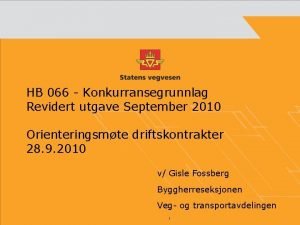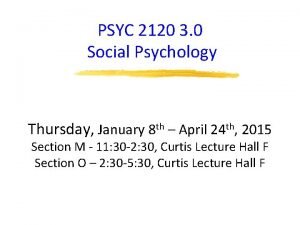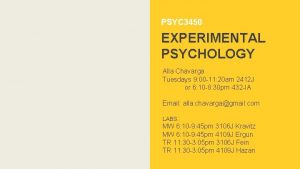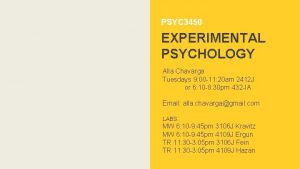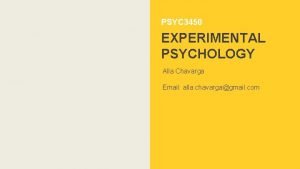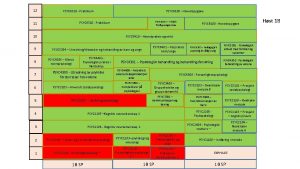PSYC 3450 EXPERIMENTAL PSYCHOLOGY Alla Chavarga Tuesdays 9












- Slides: 12

PSYC 3450 EXPERIMENTAL PSYCHOLOGY Alla Chavarga Tuesdays 9: 00 -11: 20 am 2412 J or 6: 10 -8: 30 pm 432 -IA Email: alla. chavarga@gmail. com LABS: MW 6: 10 -9: 45 pm 3106 J Kravitz MW 6: 10 -9: 45 pm 4109 J Ergun TR 11: 30 -3: 05 pm 3106 J Fein TR 11: 30 -3: 05 pm 4109 J Hazan

CHAPTER 8 Control Problems Lecture Outline Control in Between- and Within-Subjects Designs Random Assignment: Methods Order effects and how to control them Types of Developmental Designs Experimental bias & Participant Bias

CONTROL IN BETWEEN- AND WITHIN-SUBJ DESIGNS 01 Between-Subjects Comparison is between two different groups of participants; each person receives one level of IV Necessary when: • Participants in each condition have to be naïve (example: Barbara Helm study • IV is Subject variable (e. g. , gender) Main problem to solve: creating equivalent groups GROUP 1 GROUP 2

THE BARBARA HELM STUDY Female/Male Defendant ”the Burglary” ”the Swindle” Wuensch, K. L. , Castellow, W. A. , & Moore, C. H. (1991). Effects of defendant attractiveness and type of crime on juridic judgment. Journal of Social Behavior and Personality, 6, 713 -724. “On July 7, 1990, Barbara Helm/Mr. Robert Helm was arrested and subsequently indicted on criminal charges of breaking and entering and grand larceny. ” “On July 7, 1990, Barbara Helm/Mr. Robert Helm was arrested and subsequently indicted on criminal charges of obtaining money under false pretenses and grand larceny. ” Finding: Females gave the unattractive swindlers longer sentences, but attractiveness did not affect their sentencing of burglars. Why was a between-subjects design required here?

CREATING EQUIVALENT GROUPS GROUP 1 GROUP 2 Random assignment • • • Each participant has equal chance of being assigned to any group in the study Spreads potential confounds equally through all groups Can be accomplished through blocked random assignment Matching • • Deliberate control over a potential confound Use when • • • Small N per group might foil random assignment Some matching variable correlates with DV Measuring the matching variable is feasible

CREATING EQUIVALENT GROUPS: BLOCKED RANDOMIZATION

CONTROL IN BETWEEN- AND WITHIN-SUBJ DESIGNS 02 Within-Subjects Also called repeated-measures designs (same subjects in every level of an IV) Necessary when: • Comparisons within the same participant are essential (perception studies, etc) Removes influence of individual differences Main problem to solve: order effects GROUP 1 GROUP 2

CONTROL IN BETWEEN- AND WITHIN-SUBJ DESIGNS Within-Subjects 02 Also called repeated-measures designs (same subjects in every level of an IV) ORDER EFFECTS: • Order effect (practice effect) • • Sequence effect • • The absolute order # of the condition influences performance. (e. g. doing the same task 3 times) The relative order of the condition influences performance. (e. g. judgment of the weight of an object depends on which conditions preceded it) Carry-over effect • One condition changes participant in a way that carries over to subsequent trials (e. g. math and verbal tasks) GROUP 1 GROUP 2

CONTROLLING ORDER EFFECTS Counterbalancing: Altering the order of the experimental conditions • Complete counterbalancing (all possible orders = x!) • • • Test participants in every possible different order at least once Works well with only a few conditions Partial counterbalancing • Random sample of all possible combinations is selected I want to evaluate the effect of color on exam performance. I ask my class to take a test under different lighting conditions. How many possible sequences are possible with only 3 conditions (red, green, and blue) light? RGB RBG BGR BRG GRB GBR What about 4 conditions (red, yellow, green, and blue) light? RGBY RGYB RYGB RYBG RBGY RBYG GRBY GRYB GBYR GBRY GYBR GYRB BYRG BYGR BRYG BRGY BGYR BGRY YGBR YGRB YRBG YRGB YBRG YBGR

CONTROL IN DEVELOPMENTAL STUDIES Longitudinal design • Within-subjects design • Potential for attrition difficulties Cross-sectional design Cohort sequential design • • • Between-subjects design Potential for cohort effect Combines cross-sectional and longitudinal

WHY DO WE NEED CONTROL? Internal validity: the extent to which we can be confident that our result is due to the manipulation in the study External validity: the extent to which our research is generalizable outside the laboratory THREATS TO INTERNAL VALIDITY • History • Maturation • Regression to the Mean • Attrition

THE PROBLEM OF BIAS Experimenter Bias Expectancy Effect: Experimenter expectations can influence participant behavior. What to do about it: • Automate the procedure • Use a double-blind procedure Participant Bias Hawthorne effect: Effect of knowing one is in a study “Good” participants: Participants tend to be cooperative, to please the researcher Evaluation apprehension: Participants tend to behave in ideal ways so as not to be evaluated negatively Demand characteristics: Cues giving away true purpose and study’s hypothesis What to do about it: • Effective deception • Field research
 Alla chavarga
Alla chavarga Alla chavarga
Alla chavarga Ns 3450
Ns 3450 Pasodoble de la bandera
Pasodoble de la bandera Para que mi amor no sea un sentimiento letra
Para que mi amor no sea un sentimiento letra Experimental vs nonexperimental research
Experimental vs nonexperimental research Experimental vs non experimental
Experimental vs non experimental Experimental vs non experimental
Experimental vs non experimental Experimental research design types
Experimental research design types Experimental vs non experimental research
Experimental vs non experimental research Psyc 2120
Psyc 2120 Psyc 311 study guide
Psyc 311 study guide Sfu library search
Sfu library search


